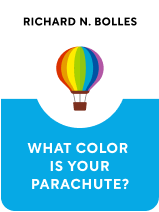

This article is an excerpt from the Shortform book guide to "What Color Is Your Parachute?" by Richard N. Bolles. Shortform has the world's best summaries and analyses of books you should be reading.
Like this article? Sign up for a free trial here .
Do you need What Color Is Your Parachute exercises? How do you apply the lessons from What Color Is Your Parachute to your own life?
These What Color Is Your Parachute exercises walk through some of the key recommendations in the book. You can apply the strategies to your life with these.
Read on for 12 What Color Is Your Parachute exercises.
What Color Is Your Parachute Exercises
The flower exercises from What Color Is Your Parachute helps you determine what you’d like to do for work.
- Think about your current or most recent job. How well does it meet the criteria of each of your seven petals? Did/do you enjoy this job?
- Imagine a job that meets the criteria on all seven of your petals. What would this job look like? (Don’t picture a specific existing job; imagine the organization’s purpose, what your duties would be, and so on.)
A bridge-person is someone you know who also knows people or organizations you’re interested in.
- Think of a job you might like to do. Who do you already know who might know someone else who’s doing the job, who works with a company who hires for the job, or who is an expert in the field?
- What online groups and forums could you join to connect with bridge-people? Consider industry-specific groups, alumni groups, geographical groups, and so on.
- Look through your connections and network on LinkedIn. Who could you approach about acting as a bridge-person?
Many employers will factor what they learn about you online into their decision to interview or hire you.
- Search your name. What comes up that you wouldn’t want an employer to see? Why? How can you get this content down?
- Consider your LinkedIn account. What information could you add to your profile to make it more complete? For example, you might be able to add details about your skills or hobbies.
- How could you increase your general online presence? For example, you might start a blog or a video series. What kind of professional content or skills could you share? How would you create it?
- What format do you think would work best for your resume: reverse chronological order, skill-focused, combo, or original? Why?
It’s important to prepare for an interview in order to make the best first impression.
- Think of an organization you’d like to work for. How would you find out more about them? Consider what parts of their website you should read, who you might conduct an informational interview with, and so on.
- It’s helpful to bring samples of relevant work to an interview. What kind of samples could you bring? Consider documents you’ve written, photos of products you’ve made, testimonials, and so on.
- All jobs require some general skills such as punctuality or commitment. Make a list of general skills that you could discuss in an interview. Then, write an example of an experience that shows you possess this skill.

———End of Preview———
Like what you just read? Read the rest of the world's best book summary and analysis of Richard N. Bolles's "What Color Is Your Parachute?" at Shortform .
Here's what you'll find in our full What Color Is Your Parachute? summary :
- How to not just find a job, but find a job you love
- Why traditional resumes don’t find you the right job
- The 7 steps to identifying your ideal career






